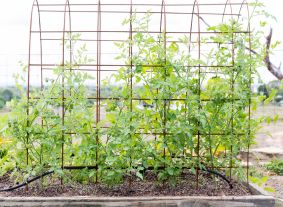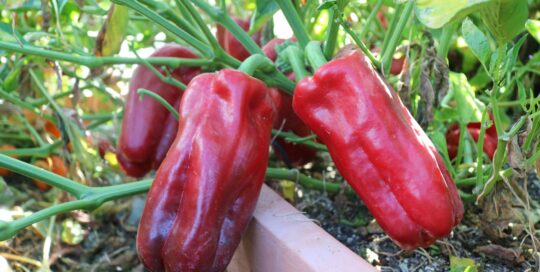What “Indeterminate Tomato” Means
Views: 433

We’re talking about indeterminate tomatoes in this edition of Just Veggies. You may recall that in the last Just Veggies we explained what the “determinate” on the plant tag means, usually in reference to tomatoes. Quick review and in a nutshell: Determinate essentially means the tomato grows to a certain height, stops growing and puts all its energy into producing tomatoes. To read more on the topic, you can find that last blog post HERE.
The Meaning of Indeterminate
Think of the word “indeterminate” to mean “indefinite.” What we mean by this is that this plant will continue to grow until a killing frost ends its life. Rather than growing to just 3-4 ft. tall as a determinate tomato plant would, these indeterminate plants will continue to produce new vines all season long, growing ever upward. And as they grow, they also continue to produce blooms, which subsequently become tomato fruit. Not only do you get new vines all season, you get fruit all season, too. In fact, I’ve harvested fresh cherry tomatoes as late in the season as the week of Thanksgiving—and that’s way up here in New England (and it was an extraordinarily warm fall).
Important Characteristics of an Indeterminate Tomato
Determinate, indeterminate … what’s the big deal and why should I care? Well, knowledge is power, right? Knowing the characteristics of the two will help you determine which type is right for you and also how to manage your tomato crop.
- Because their growth is continuous and prolonged, you’ll need to use more supports for indeterminate tomatoes. Consider using larger tomato cages or the Florida Weave technique.
- Indeterminate tomatoes will form and ripen fruit for months on end until the first killing frost. This is in contrast to determinate tomatoes that concentrate the harvest in a roughly two-week time interval. This is great for folks who don’t want to can or freeze an all-at-once tomato haul from determinate tomato plants.
- Indeterminate tomatoes aren’t really suited for growing in containers, or at least in small containers. They’ll need to be constantly pruned and maintained to check growth, unless you have the space around the plant to let those vines cascade down and around.
- Indeterminate tomato plants do require regular maintenance, such as pinching off suckers, tying vines to supports and trimming out growth to allow for air circulation in and around the plant. The reason behind this last task is to help reduce stagnant air and prevent the spread of air- and water-borne diseases.
- Many of the esteemed and flavorful heirloom tomatoes happen to be of the indeterminate type. They may take a bit more work to maintain, but the flavor explosion is well worth it!
And now you know all about determinate and indeterminate tomatoes. You may find that a few of each will best suit your needs. Whichever you choose, at the end of your harvest you’ll feel that tomato season really isn’t ever long enough.
Meet Ellen Wells
When you’re raised on a farm, you can’t help but know a thing or two about gardening. Ellen Wells is our expert on edible gardening.…
Ellen's Recent Posts

Pepper Red Impact an All-America Selections Winner






